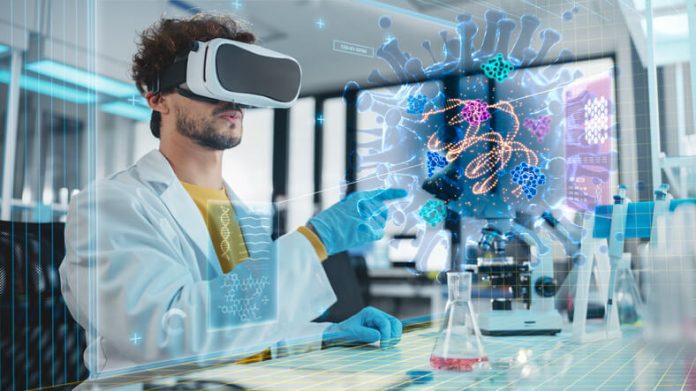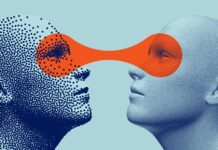For healthcare, there are endless possibilities in alternate realms. There are many legitimate uses for augmented/virtual reality (AR/VR) in healthcare, from education to visualization of veins or surgical procedures to relaxation for patients or the treatment of post-traumatic stress disorder (PTSD). Although these technologies are vastly distinct, they are frequently used in the same context. You can see how AR can significantly affect medicine by looking at these 9 instances.
The difference between AR and VR
Real-world environments can be enhanced through augmented reality or AR (think of Google Glass). An image of the real world is created by projecting digital information onto the real environment.
Using a VR headset, the user’s eyes (and hence reality) are entirely shielded from the outside world. It provides an immersive experience by shutting out the outside world. These two worlds are brought together in mixed reality. To create an immersive experience, it combines the physical and digital worlds.
The most well-known “relative” of augmented reality, virtual reality (VR), totally isolates the user from the real world. AR is unique in two ways: it keeps users connected to the real world and quickly delivers information to their eyes. Because of these unique characteristics, AR has the potential to be a major player in medical technology in the future.
Augmented Reality: The future of healthcare
In healthcare, augmented reality has had its ups and downs. Today, technology appears to be at a standstill as it awaits the next breakthrough to catapult it even further ahead of where it is now.
AR has a role to play in healthcare in the future. Just check out our conversation with Robert Scoble, a pioneer in the field of mixed reality. Let’s look at what’s already achievable in the present day.
The best examples of augmented and virtual reality in medicine and healthcare
1. Augmented reality can save lives by showing defibrillators nearby
Would you be able to help someone who has collapsed? You’d have a million ideas racing through your head, but you’d reach for your phone regardless of whether you wanted to call an ambulance, a doctor, or even your mom. To aid you out, apps are available, and The AED4EU app is a good example. As a result of this new application, users can add locations where automated external defibrillators (AEDs) are located.
This is why augmented reality helps persons in need or danger by providing them with vital information.
2. Google Glass to help new mothers struggling with breastfeeding
Even if Google Glass was unable to take over the world, it was employed to assist new moms in the process of breastfeeding. Even if it was once a great idea, little is known about it now (thus its inclusion on this list).
Women in need may access expert assistance at any time of day or night without having to put their babies down. Consultations rise to a new level when the patient’s perspective is shared.
Unfortunately, there is no longer a product like this available, and the trial didn’t appear to meet expectations.
3. Patients can describe their symptoms better through augmented reality
When asked to adequately describe their symptoms by their doctors, patients frequently experience difficulty. A medical situation might sometimes cause people to be overly concerned or dismissive of the issue. Augmented reality could be the key to better patient education in the field of ophthalmology.
Oculenz is a medication prescribed to those who have lost their central vision. Using apps like Oculenz, clinicians can simulate a patient’s eyesight with a particular ailment.
4. Nurses can find veins easier with augmented reality
AccuVein utilizes augmented reality (AR) technology for both nurses and patients. An AccuVein marketing specialist noted that 40% of IV injections miss the vein on the first stick. With the statistics worsening in younger patients and those who are elderly or infirm.
When drawing blood, nurses and doctors can use augmented reality to improve their skills by employing a handheld scanner that projections over the skin and shows them where the veins are in their patients’ bodies. Professionals in the healthcare industry could benefit from new tools like these.
5. Motivating runners through zombies
Imagine strolling down a dark alley when you hear a strange creature groaning and slowly moving. Realizing that they are being pursued by a “real zombie” will probably motivate even the most slothful individuals to get moving. The Zombies, Run! App’s central idea is to get people to run away from zombies.
Everything becomes more enjoyable when it’s made into a game because individuals are motivated by fear, and the game takes advantage of this. For those who find running tedious, this software is a godsend. Seeing and hearing imaginary zombies projected on your phone or device screen will boost your speed and endurance, and you’ll also get the sensation that time is flying by.
6. Pharma companies providing more innovative drug information
Have you ever wondered how medicine interacts with your system? However, I bet your interest in learning how pills and medicines work was dashed after reading the tedious and incomprehensible drug description. It’s about to get a lot more interesting, thanks to augmented reality’s advent.
Rather than reading long descriptions on the label, patients may see in 3D how the drug works with AR. With augmented reality devices, researchers can keep tabs on their investigations. Workers in pharmaceutical companies might begin working immediately without any on-the-job training because the device would teach them exactly what to do and how to do it.
7. Augmented reality can assist surgeons in the OR
Patients and doctors alike understand the critical need for surgical precision. Surgeons can now use AR to improve their surgical efficiency. Medical apps that use augmented reality (AR) have the potential to save lives and improve the quality of treatment for patients undergoing minimally invasive procedures or those with liver tumors.
Sync Surgeons can now have “X-ray vision” thanks to a new software application developed by AR that integrates digitally enhanced images straight into a surgical microscope.
8. Hololens changing medical education and the study of anatomy
The Cleveland Clinic and Case Western Reserve University have teamed up with Microsoft to release HoloAnatomy, a HoloLens app that makes it simple to see the human body.
Microsoft’s HoloLens Headset users may see everything from muscles to the tiniest veins on a live holographic model before their eyes. Students can see the human body in 3D instead of the conventional working approach of black-and-white photographs and written descriptions in books, which I believe would change medical education.
There is no reason to suppose that we won’t be able to improve it in the future. The only way to prepare for this future is to educate ourselves and our children as early as possible.
9. Teaching kids about the human body
Curiscope is an augmented and virtual reality company established in the United Kingdom. To look into the human body in hologram form, they created the Virtuali-tee T-shirt. Anatomy is brought to life in such a way by Virtuali-tee that it represents Arthur C. Clarke’s famous third law of enchantment. Any advanced technology is indistinguishable from magic, according to this quote.
Which toy did you play with most when you were a child? For example, I’ve always had a soft spot for anything LEGO-related. One of the world’s greatest pastimes is putting together small LEGO pieces into something new, such as a castle, a car, or a city. Imagination and creativity are sparked, and you’ll improve your ability to see the big picture and focus on the details. There seem to be many video games trying to emulate the LEGO experience.
[su_dovider]


































